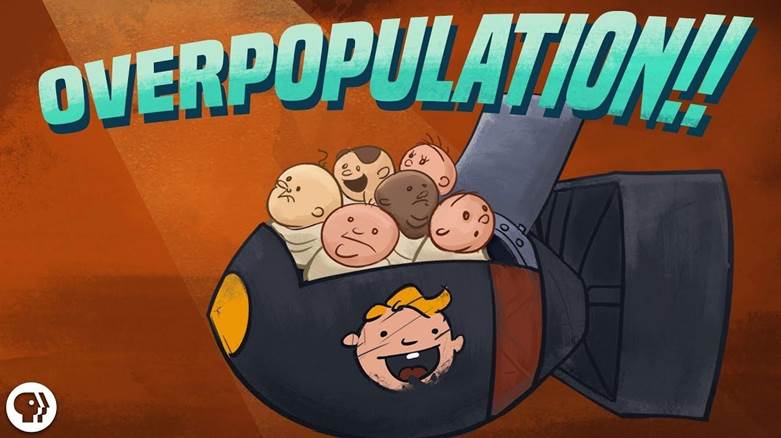THE POPULATION BOMB

Copyright infringement not intended
About
- The Population Bomb is a 1968 book written by Stanford University Professor Paul R. Ehrlich and his wife, Anne Ehrlich. It predicted worldwide famine due to overpopulation, as well as other major societal upheavals, and advocated immediate action to limit population growth.
World Population 2022 Report
- The State of World Population is an annual report published by the United Nations Population Fund (UNFPA).
- The theme of the 2022 report “Seeing the Unseen: The case for action in the neglected crisis of unintended pregnancy”.
- The Report covers and analyses developments and trends in world population and demographics, as well as shedding light on specific regions, countries and population groups and the unique challenges they face.
- The UNFPA report has used country-based surveys and datasets to arrive at its conclusions.
Key findings of the Report
- In November 2022, there will be 8 billion humans on planet Earth.
- There are around 121 million or 12.1 crore unintended (unplanned or unwanted) pregnancies across the world every year, and one in every seven of these occurs in India.
- The number of unintended pregnancies around the world accounted for 48 % of all pregnancies.
- 61 % of the unplanned pregnancies ended in abortion. In Other words “almost 30% of all pregnancies, end in abortion”
- What is also concerning is that these abortions are unsafe, putting women and young girls at unnecessary risk.
- The report pointed out that not all teenage deliveries across the globe result from unintended pregnancies.
- The majority of births by girls aged under 18 years took place within marriage, suggesting that many of those pregnancies could be classified as intended.
- The report stated that 13% of women in developing countries begin childbearing before they turn 18.
- 75% of them have their first child at the age of 14 and the second before turning 20.
- Moreover, 40% of those who give birth twice go on to have a third child before turning 20.
- Studies estimated that more than 20% of displaced women worldwide experience sexual violence.
- The Covid-19 crisis has also hugely disrupted healthcare and contraceptive supplies, leading to up to 1.4 million unintended pregnancies in the first year of the pandemic alone.
- The war in Ukraine and other conflicts and crises around the world are expected to drive an increase in unintended pregnancies, as access to contraception is disrupted and sexual violence increases.
- Globally, an estimated 257 million women who want to avoid pregnancy are not using safe, modern methods of contraception, and where data is available, nearly a quarter of all women are not able to say no to sex.
- Key factors that contribute to unintended pregnancies include:
- Lack of sexual and reproductive health care and information
- Contraceptive options that don't suit women's bodies or circumstances.
- Harmful norms and stigma surrounding women controlling their fertility and bodies.
- Sexual violence and reproductive coercion.
- Judgmental attitudes or shaming in health services.
- Poverty and stalled economic development.
- Gender inequality.
- In a Patriarchal and unequal society, there is Social pressure and family pressure on women and girls to become mothers.
- An unintended pregnancy is not necessarily a personal failure and may be due to the lack of autonomy society allows or the value placed on women’s lives.
Key Findings about India in the Report
- Studies from India indicate that unintended pregnancy is associated with lower maternal healthcare utilisation and poorer infant and maternal health outcomes.
- The report highlighted the need to focus on avoiding unintended pregnancies.
- India’s key priority now is to address the need for family planning/contraceptives and improve access to safe abortions.
- It suggested that there is a need to invest in research to better understand “the drivers and impacts of unintended pregnancy”.
- A total of 23.3% of women aged 20-24 years were married before the age of 18, according to the data from India’s fifth National Family Health Survey (NFHS-5).
- The report mentioned that “India has made major inroads in terms of sexual and reproductive health and rights. The population is stabilising, the number of preventable maternal deaths has reduced, and there is increased uptake of reversible and safe modern methods for family planning”.
Way Forward
- Safe contraception services are essential to upholding women’s reproductive rights and preventing pregnancies, these can have significant implications for the mother, family and larger society.
- Expanding the reach and range of contraceptives can prevent early pregnancy and unintended pregnancies.
- At a micro level, planned pregnancies help eliminate poor health outcomes like the risk of maternal or infant mortality.
- At a macro level, it helps minimise negative outcomes of large family sizes like a strain on resources, poorer economic outcomes for the mother, increased anxiety for the parents, and financial stress.
- Thus, facilitating a reduction in unplanned pregnancies can have cascading family and society-level benefits.




1.png)
